Inside the Kids Anxiety Journal: Tools That Help Children Feel Safe and Seen.
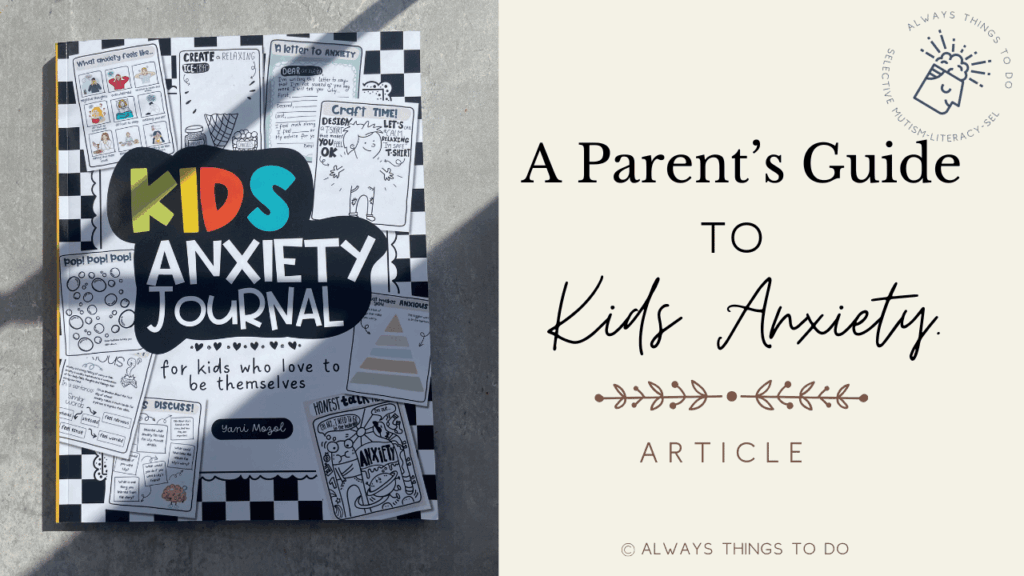
Anxiety in kids often has two very different faces—depending on who’s looking.
For us, the parents whose children live under its weight every day, anxiety is personal. It’s not just a label—it’s a constant, exhausting reality. It’s the “big grey cloud” that quietly follows your child everywhere and sometimes looms over the whole family. It shows up in morning meltdowns, bedtime battles, and the heartbreak of watching your child shrink away from things that once brought them joy.
But from the perspective of social caregivers—teachers, coaches, school aides—anxiety might look more like behavior problems: trouble making friends, shutting down in class, acting out, or not following directions. To them, it might seem like defiance or distraction when in reality, it’s fear and overwhelm.
I’ve lived both perspectives. As a mom to a child with anxiety, I’ve felt the helplessness. And as a teacher, I’ve felt the emotional drain of trying to be a safe space for every child—especially those carrying invisible burdens from unstable homes, poverty, or family trauma. Whether at home or in the classroom, anxiety is messy and demanding.
This article isn’t about school-based strategies—because let’s be honest, much of what happens in school is out of our hands as parents. This is about the part we can control: the support we offer at home, one day at a time.
Here are three powerful truths I’ve learned on this journey:
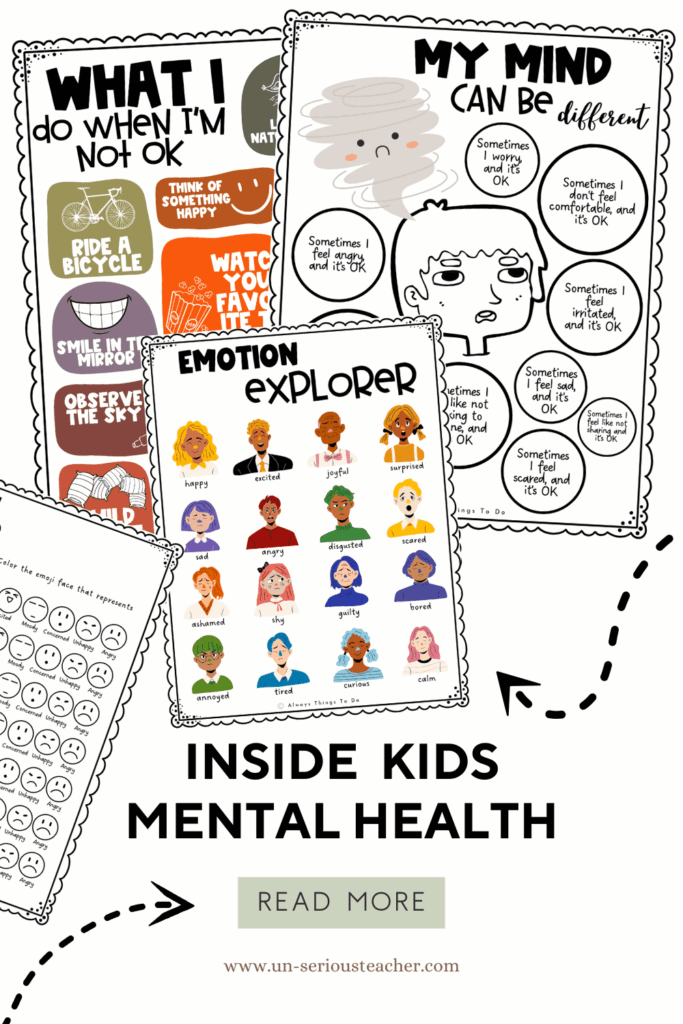
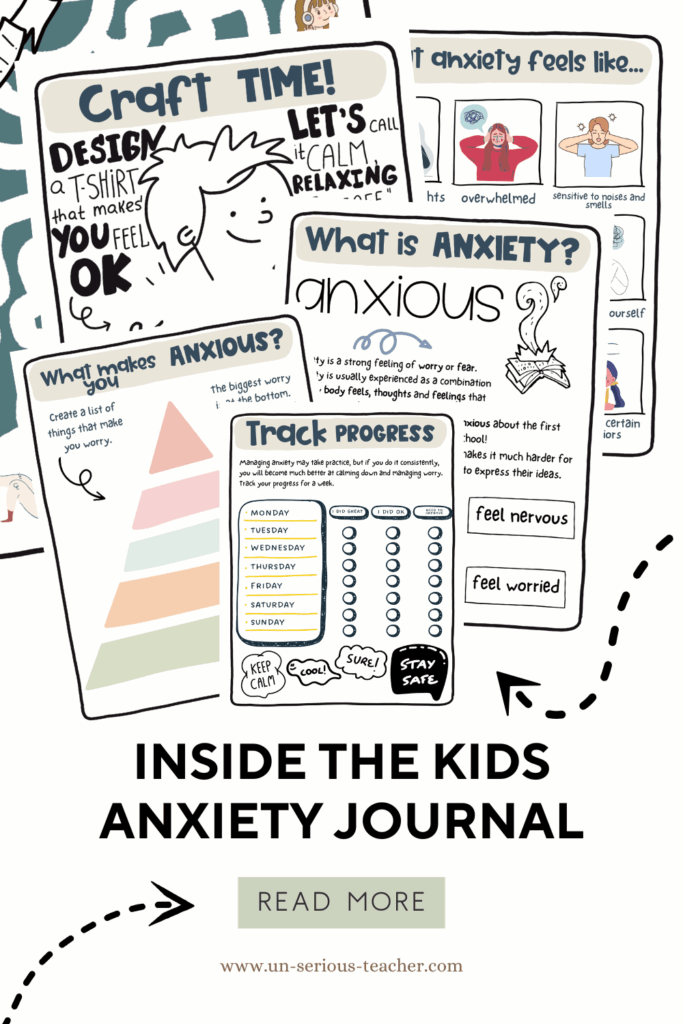
The First Step Isn’t a Journal—It’s You.
Before diving into tools and strategies to help your anxious child, take a moment to ask yourself a simple but profound question:
How am I really doing?
So often, we rush into doing—finding the right books, printing the worksheets, scheduling therapy appointments—because we love our children deeply and want to fix what feels broken. But anxiety isn’t something you can “fix” overnight. And before we can be the calm in our child’s storm, we need to notice the weather inside ourselves.
Dr. Gabor Maté, a physician and internationally respected expert on childhood development, trauma, and addiction, writes:
“A child’s capacity to handle stress is shaped by the emotional state of their caregivers.”
– Dr. Gabor Maté, Scattered Minds
Our children don’t just hear what we say—they feel how we are. If we’re constantly running on empty, overwhelmed, irritable, or numb, they sense it. If we’re anxious, even if we don’t talk about it, our nervous system communicates it to theirs. This emotional mirroring is known as co-regulation—a process by which a child learns to manage their emotions through their caregiver’s presence and cues.
Maté puts it simply:
“The child does not become what we tell them to be. The child becomes what we are.”
– Dr. Gabor Maté, Hold On to Your Kids
So what does this mean for parents of anxious children?
It means that before we offer support, we need to become support. We need to tune into our own mental and emotional state with compassion and honesty.
Here are a few examples:
- If your child has frequent morning anxiety before school, and you’re also rushing around, silently stressed, your child will pick up on that tension. Try waking up earlier to give yourself a few quiet moments before the day begins—your grounded energy will influence theirs.
- If your child shuts down or melts down when overwhelmed, and your first instinct is to snap or “fix” the situation, try pausing. Take a few deep breaths, name your feelings silently, and remind yourself: My calm is more important than control right now.
- If you’re feeling emotionally drained after weeks of worry, give yourself permission to say, “I need support too.” This might mean a conversation with a friend, journaling, a therapy session, or even just taking a break from your own high expectations.
Maté emphasizes the link between a parent’s unresolved stress and a child’s behavior:
“When parents are emotionally stressed, their children are more likely to experience emotional dysregulation, not because the parents don’t love them, but because stressed adults cannot fully attune to a child’s needs.”
– Dr. Gabor Maté, The Myth of Normal
This isn’t about perfection.
You don’t need to be an endlessly patient, always-positive superhero. In fact, trying to be perfect can add even more stress. What your child needs most is your presence, not your performance.
Being present means noticing your own triggers, slowing down when you’re overwhelmed, and making space for your own healing. It also means modeling for your child that emotions—even hard ones—are okay and manageable.
Start small:
- Ask yourself each day: What am I feeling right now? What do I need?
- Model naming your emotions aloud: “I’m feeling worried today, so I’m taking a few breaths.”
- Repair when needed: “I was upset earlier. I’m sorry. I’m working on staying calm when things feel hard.”
These seemingly small steps ripple out. When you work on regulating yourself, you create the foundation for your child to feel safe, seen, and emotionally supported. And from that place, they’re far more likely to grow the tools they need to manage anxiety in healthy, lasting ways.
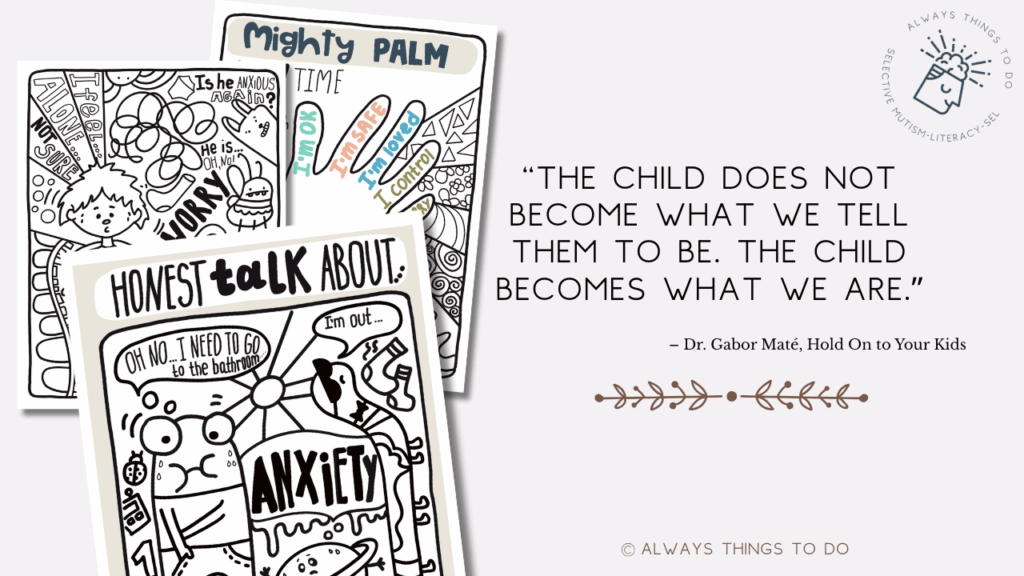
How to Use a Kids Anxiety Journal or Book Effectively: The Secret Is Consistency.
If you’ve ever Googled “how to help my anxious child,” you’ve probably seen a mountain of suggestions: calming books, printable worry journals, coping skills worksheets, affirmation cards, sensory toys, breathing videos, mindfulness apps… the list goes on.
It can feel both empowering and overwhelming. And here’s the truth: all of those tools can be helpful—but only if they’re used consistently.
Think of it like going to the gym. Buying the membership, getting new sneakers, and printing out a workout plan might feel productive, but none of it matters unless you actually show up—over and over. It’s the same with anxiety support tools.
Reading a calming bedtime story once a month won’t help your child build a coping habit. But making that story part of a nightly routine tells their brain:
“This is a safe moment. We’re together. I can let go now.”
It’s not about the tool itself—it’s about how it’s woven into daily life.
Dr. Gabor Maté reminds us:
“Love felt by the child does not depend on how much the parent says ‘I love you,’ but on how consistently the parent can be emotionally present.”
– Dr. Gabor Maté, Hold On to Your Kids
Consistency builds trust. And trust is the soil where resilience grows.
Let’s take a look at a few simple examples:
- A Feelings Chart by the Fridge: Every afternoon, check in together: “Which face matches how you’re feeling today?” This small moment helps children name their emotions—and helps you notice patterns.
- Morning Breathing Ritual: Three slow breaths together before leaving for school. In just one minute, you’re modeling self-regulation and showing that emotions are welcome, not scary.
- A Worry Jar or Journal: Before bed, invite your child to “put their worries away” by drawing or writing one thought. Over time, this becomes a trusted tool to offload anxiety.
None of these strategies are elaborate. But what they are is reliable. When used regularly, they signal to your child:
“You are not alone with your feelings. I’m here. And we have ways to work through it together.”
What if I can’t keep up with everything?
You don’t have to. In fact, less is more—especially when you’re building new emotional habits with your child. Start small. Choose one tool. Maybe it’s a breathing game, a calming bedtime story, or five minutes of coloring together while chatting about the day.
What matters most is that you show up for that practice again and again.
When kids know what to expect, they begin to internalize the rhythm. Repetition leads to regulation.
Dr. Maté’s research affirms this point:
“Children can tolerate a lot of frustration and stress—if they have a consistent, emotionally available adult who helps them process it.”
– Dr. Gabor Maté, The Myth of Normal
In short:
- Don’t try to do it all.
- Don’t worry if it feels simple.
- Do it consistently.
- Let your presence be the magic that makes the tool work.
Because at the heart of every worksheet, chart, or story is a relationship. And your relationship with your child is the most powerful tool of all.
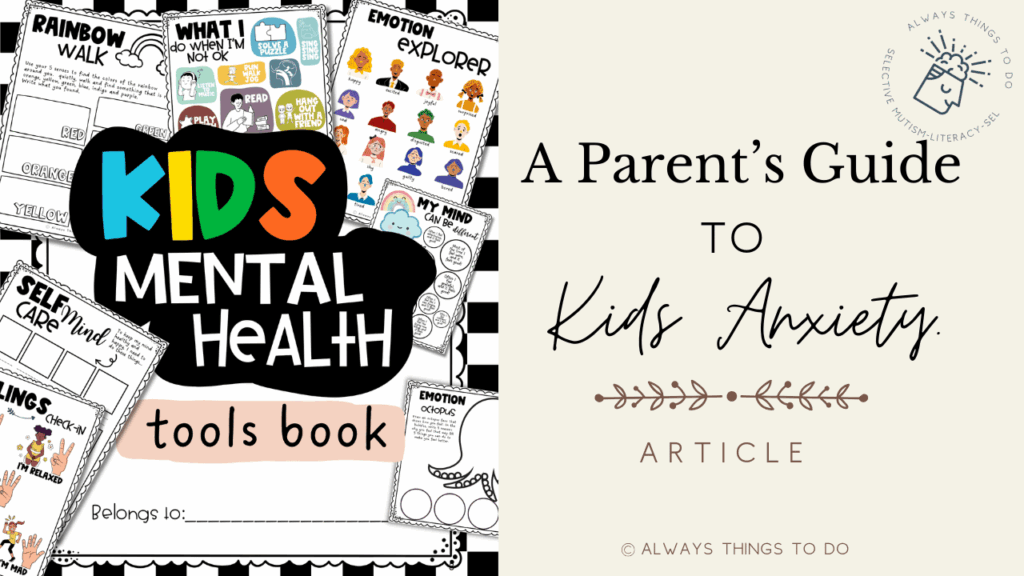
The Long Game of Kids Anxiety Relief: How Daily Use of an Anxiety Journal or Book Builds Confidence Over Time.
When you’re supporting a child who struggles with anxiety, it’s natural to want to see quick results. You try a new calming strategy, read a book together, or use a worksheet—and hope for a big shift. But the truth is, real progress with anxiety takes time, repetition, and a lot of patience.
Think of it more like building a habit or learning a new skill. It doesn’t happen in one day—and there will be ups and downs along the way.
For example:
- You might teach your child how to take deep breaths when they’re overwhelmed, and for the first few weeks, they might roll their eyes or say, “This doesn’t help.” That’s okay—keep practicing it together, gently and consistently.
- You might create a calming bedtime routine with soft music and a cozy story, and some nights it goes smoothly… and other nights, the worry creeps back in. That’s normal too.
- You might go weeks without a panic moment, and then suddenly have a hard day again. That doesn’t mean you’re back to square one—it just means your child is still learning how to cope.
Dr. Gabor Maté reminds us:
“Development is not about getting rid of problems. It’s about growing the capacity to meet them.”
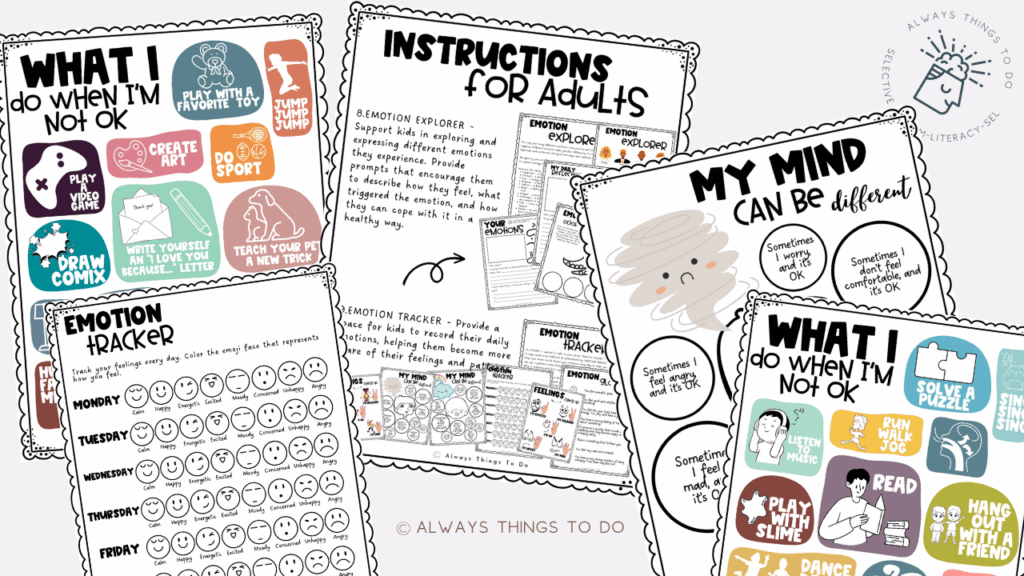
Your daily efforts—talking about feelings, offering support, building routines—might feel small, but they matter more than you think. Over time, they help your child build an internal toolkit: ways to calm their body, name their emotions, and reach out when they need help.
Here are a few practical ways to think long-term:
- Make things predictable. Children feel safer when they know what to expect. Try keeping regular routines for meals, bedtime, or homework. Even a simple “check-in” after school can become a powerful anchor.
- Celebrate the small wins. Did your child try a breathing strategy today—even if just once? That counts. Did they go to school after a tough morning? That’s growth.
- Expect setbacks. Progress isn’t always a straight line. If your child has a rough day after doing well for weeks, don’t panic. Just meet them with calm, and try again tomorrow.
Healing isn’t about doing everything perfectly—it’s about showing up, over and over, with love and patience.
So even when it feels like nothing is working, keep going. The bedtime story, the deep breaths, the check-ins, the hugs after a meltdown—they’re all adding up. Maybe not in ways you can measure right now, but they are shaping your child’s emotional future.
Your consistency today becomes your child’s confidence tomorrow.
And that’s the long game we’re playing.


